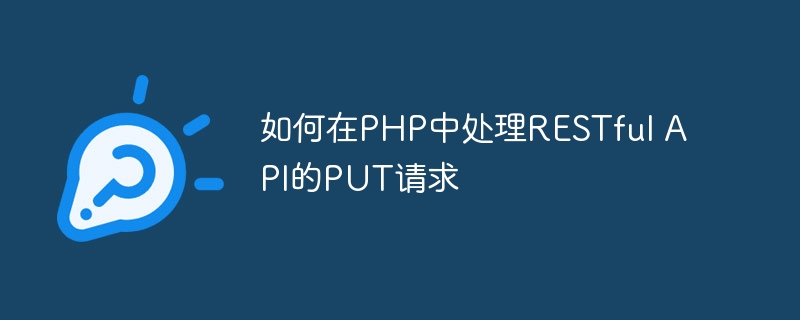How to handle PUT request for RESTful API in PHP

How to handle PUT requests for RESTful APIs in PHP
When developing web applications, it is very common to use RESTful APIs. Among them, PUT requests are usually used to update existing resources. This article will introduce how to handle PUT requests for RESTful APIs in PHP and provide code examples.
Before processing the PUT request, we first need to understand the characteristics of the PUT request. A PUT request is an HTTP method for updating a resource that requires the client to send an updated representation of the entire resource to the server. Unlike POST requests, PUT requests require a complete replacement of the resource rather than just updating some properties. Therefore, when processing a PUT request, we need to obtain the updated resource representation and save it to a database or other storage medium.
The following are the general steps for processing PUT requests:
- Verify the request method: Before receiving the request, you first need to verify whether the request method is PUT. You can use PHP's $_SERVER['REQUEST_METHOD'] global variable to get the request method. If the request method is not PUT, an error response is returned.
if ($_SERVER['REQUEST_METHOD'] !== 'PUT') {
http_response_code(405); // Method Not Allowed
echo json_encode(['error' => 'Invalid request method']);
exit();
}- Get request data: Include the updated resource representation in the body of the request. We need to get and parse this data from the request body. The request body can be read using the file_get_contents() function and parsed into a PHP array or object using the json_decode() function.
$requestData = json_decode(file_get_contents('php://input'), true);
if ($requestData === null) {
http_response_code(400); // Bad Request
echo json_encode(['error' => 'Invalid request data']);
exit();
}- Perform update operations: Perform corresponding update operations based on business logic and requirements. For example, updated data can be saved to a database. It is assumed here that there is a function named updateResource() to perform the update operation.
$result = updateResource($requestData);
if ($result === false) {
http_response_code(500); // Internal Server Error
echo json_encode(['error' => 'Error updating resource']);
exit();
}- Return response: Based on the result of the operation, return an appropriate response. Common ones include successful response, error response, etc.
http_response_code(200); // OK echo json_encode(['message' => 'Resource updated successfully']);
Based on the above steps, we can write an example of a PHP script that handles PUT requests:
Copy after login
Through the above example, we can process PUT requests and update resources. In actual applications, corresponding modifications and expansions can be made according to specific business needs and data storage methods.
To sum up, to process the PUT request of the RESTful API, we need to verify the request method, obtain the request data, perform the update operation, and then return the appropriate response. The above is a simple example that can be modified and expanded according to actual conditions.
The above is the detailed content of How to handle PUT request for RESTful API in PHP. For more information, please follow other related articles on the PHP Chinese website!

Hot AI Tools

Undresser.AI Undress
AI-powered app for creating realistic nude photos

AI Clothes Remover
Online AI tool for removing clothes from photos.

Undress AI Tool
Undress images for free

Clothoff.io
AI clothes remover

AI Hentai Generator
Generate AI Hentai for free.

Hot Article

Hot Tools

Notepad++7.3.1
Easy-to-use and free code editor

SublimeText3 Chinese version
Chinese version, very easy to use

Zend Studio 13.0.1
Powerful PHP integrated development environment

Dreamweaver CS6
Visual web development tools

SublimeText3 Mac version
God-level code editing software (SublimeText3)

Hot Topics
 CakePHP Project Configuration
Sep 10, 2024 pm 05:25 PM
CakePHP Project Configuration
Sep 10, 2024 pm 05:25 PM
In this chapter, we will understand the Environment Variables, General Configuration, Database Configuration and Email Configuration in CakePHP.
 PHP 8.4 Installation and Upgrade guide for Ubuntu and Debian
Dec 24, 2024 pm 04:42 PM
PHP 8.4 Installation and Upgrade guide for Ubuntu and Debian
Dec 24, 2024 pm 04:42 PM
PHP 8.4 brings several new features, security improvements, and performance improvements with healthy amounts of feature deprecations and removals. This guide explains how to install PHP 8.4 or upgrade to PHP 8.4 on Ubuntu, Debian, or their derivati
 CakePHP Date and Time
Sep 10, 2024 pm 05:27 PM
CakePHP Date and Time
Sep 10, 2024 pm 05:27 PM
To work with date and time in cakephp4, we are going to make use of the available FrozenTime class.
 CakePHP File upload
Sep 10, 2024 pm 05:27 PM
CakePHP File upload
Sep 10, 2024 pm 05:27 PM
To work on file upload we are going to use the form helper. Here, is an example for file upload.
 CakePHP Routing
Sep 10, 2024 pm 05:25 PM
CakePHP Routing
Sep 10, 2024 pm 05:25 PM
In this chapter, we are going to learn the following topics related to routing ?
 Discuss CakePHP
Sep 10, 2024 pm 05:28 PM
Discuss CakePHP
Sep 10, 2024 pm 05:28 PM
CakePHP is an open-source framework for PHP. It is intended to make developing, deploying and maintaining applications much easier. CakePHP is based on a MVC-like architecture that is both powerful and easy to grasp. Models, Views, and Controllers gu
 CakePHP Creating Validators
Sep 10, 2024 pm 05:26 PM
CakePHP Creating Validators
Sep 10, 2024 pm 05:26 PM
Validator can be created by adding the following two lines in the controller.
 CakePHP Working with Database
Sep 10, 2024 pm 05:25 PM
CakePHP Working with Database
Sep 10, 2024 pm 05:25 PM
Working with database in CakePHP is very easy. We will understand the CRUD (Create, Read, Update, Delete) operations in this chapter.






